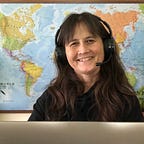One way to diversify your outdoor programs for summer school
In the Washington Post, there is an article about summer school and how summer programming needs to address lost instructional time and the overwhelming need for social-emotional learning due to the pandemic.
Education Secretary Miguel Cardona said, “districts will need to work with local community groups and organizations such as Boys & Girls Clubs of America to create additional learning opportunities and experiences for children.”
It makes sense that people think of organizations first. Their presence is significant and observable. They have a brick-and-mortar address. Their names are familiar.
However, I would like to note there are independent professionals working in communities who are also capable of working with school districts and teachers to co-create unique summertime learning opportunities.
If you are involved in organizing the summer school program for a school district and are looking for new community partners, consider the independent educators in your community.
If you are looking for partners involved in environmental education, consider the individuals who lead independent outdoor initiatives in addition to considering museums, zoos, nature centers, and gardens.
The professionals I speak of are independent environmental education (EE) professionals. These are individuals who have experience creating and leading public programs and initiatives in various disciplines. I know this because I am one. I know I am not the only one out there because I host conversations with other professionals on my podcast Talaterra. On the podcast, I have spoken with individuals from many fields. Here is a short list: game design, permaculture, social science, museum education, graphic novels, scientific illustration, nature journaling, biophilic design, architecture and planning, regenerative farming, poetry, amphibian conservation, botany, photography, mural design, and expeditionary art. That’s right, a real-life expeditionary artist.
This list is not complete. You can view more examples by browsing the podcast’s playlist.
If you’re unsure about the qualifications of independent environmental educators, I encourage you to listen to past episodes and explore the show notes to learn more about each guest. I think you will be impressed by their bodies of work and the initiatives they lead.
Are you interested in meeting some of these professionals in person? If so, I encourage you to consider participating in the EE Forward Summit next month. The EE Forward Summit is an interdisciplinary professional development and partnership-building event highlighting the contributions of independent professionals who connect the public with the outdoors.
Next month the Summit will be about Water. Leading conversations are individuals who will address the following topics: water literacy, watersheds, partnership-building, storytelling, regenerative agriculture, interpreting place through sound, and using the senses to document habitat. The founders of the Amphibian Foundation will also be there to share how they successfully brought their in-person programs online during the pandemic.
The EE Forward Summit provides an opportunity to speak with and learn from individuals who create change in their communities and their respective disciplines. It is also an opportunity to establish relationships with potential community partners. If you’re interested, we’d love to meet you.
To learn more, view the Summit’s schedule.
Thank you to McGraw Hill for bringing attention to the Washington Post article.
